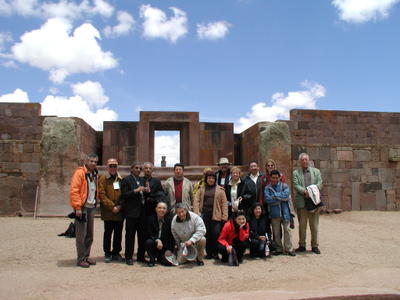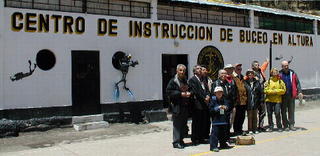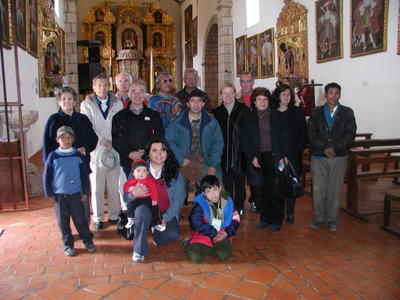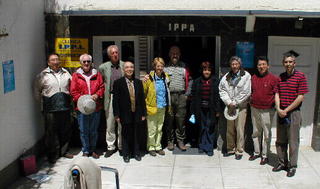 |
SYMPOSIUM |
|
|
Oct 1 - 8, 2005 La Paz - Bolivia |
||
|
|
|
High Altitude
Pathology Clinica IPPA |
| Want
to view our 1st Announcement ? |
| Post Symposium follow-up |
POST SYMPOSIUM FOLLOW-UP
By the organizers of the
First World Congress on High Altitude Medicine and Physiology:
Tuesday, October 25, 2005
This follow-up of the symposium will give insight into the actual event and how it evolved. It had a unique style since it was an itinerant meeting where the conferences were carried out in different cities and environments in order to show our visitors life at high altitude.
The city of La Paz (3510 m) was the starting point, continued by the ruins of Tiahuanacu (a pre-Inca civilization 3870 m), followed by the meeting at the Lake Titicaca (3800 m) and visit to the High Altitude Diving Center of the Bolivian Navy and finally a visit to the city of Potosi (4000 m), all on schedule. To carry out such a program in an underdeveloped country with many social and political conflicts was indeed a challenge that turned out perfect, thanks to careful planning considering multiple variables and a profound knowledge of the social and weather conditions, in Bolivia.
The overall evaluation gives as a result: an extraordinary success. For one it received the support of important international institutions such as the UNESCO and the Third World Academy of Sciences along with the High Altitude Pathology Institute and Zubieta University in La Paz, Bolivia. Furthermore, the support of the Bolivian Military Academy and Navy and last but not least the participation and support of the Vice-Chancellor of Bolivia, Prof. Dr. Jorge Asín-Capriles. The presence of prestigious scientists from different countries provided high quality science in Bolivia.
All the program was completed as planned, the opening and closing dinners were lively and enjoyed by everyone with interviews by the local press. The conferences conveyed outstanding scientists from top institutions in the world: Denmark, Canada, US, Germany, Japan, India, Australia, Peru and Bolivia. The talks were of high quality and followed by very stimulating discussions and gave rise to many new ideas.
The conferences were, although in different topics all related and the environment of free discussion and comments was strongly supported. Many interesting proposals were performed. There was true scientific democracy as all speakers were chairmen on some session thereby giving equal opportunities to everyone.
Every speaker and participant was able to arrive to La Paz feel the effects of hypoxia yet adapt adequately the first 48 hours as planned, with the exception of two scientists that arrived a little later. No one suffered from Acute Mountain Sickness except one of the colleagues that had a mild headache as he arrived late. No one suffered any other type of disease since hygiene was strongly controlled, throughout the whole week. The final ascent to the city of Potosí likewise was uneventful.
Organizers
Prof. Gustavo Zubieta-Castillo
Chairman
Prof. Jorge Asín
International
Relations
K.S. Parthasarthy Partha
Member
Organizing Committee India
Dr. Luis Zubieta-Calleja
General Assistance
Claudia Aguilar
Coordinator
Jorge Castillo and Mónica Rivera
Medical Student affairs
Viviana Calleja
Tourist and hotel coordinator
Prof. Gustavo
Zubieta-Calleja
Scientific
Committe
Prof. Venkatesh Thuppil
Member
Organizing Committee India
Lic. Nancy Zubieta
Coordination
Maria Eugenia Quiroga Multiple support
Clotilde Calleja
Nutricionist advice
Michael Moretti
Arrow-Marketing Group
Rafaela and Natalia Zubieta
General support
Prof. Dr. Gustavo Zubieta-Castillo,
Chairman of the symposium
Oct 3, 2005
Distinguished guests and colleagues:
In 1994 we organized the 1st World Congress of High Altitude Medicine and Physiology. It was a great success, because we had the presence of the most distinguished scientists in the field of high altitude science to which we have dedicated our knowledge and our lives.
Today we are again together with you who missed the first world congress due to different circumstances except a very few. Since that time we made great progress in the research of: high altitude medical problems we have to solve and the impact of hypoxia in permanent residents of high altitude or those that come to live from the low lands.
Today we are here with the same goal: to take one step further and open new frontiers. This is a big challenge we impose on ourselves and we are sure and predict that with your participation, with your outstanding quality as scientists and humanists, we will open a new era. In this symposium, we will give you equal opportunities for your talks and time to express freely your points of view, sometimes controversial but full of questions and answers, since this is how science can progress.
You are visiting a country full of contrast in geography and people who live in this beautiful land. The world, as never before is in permanent global conflict where people, paradoxically, are ever more intelligent, with greater knowledge, easily accessible, yet with increasing difficulties in order to understand each other. Everyone is going in different directions with different philosophical concepts and religions, different politics and economy.
You are in this building of Zubieta University, which is only the skeleton of many things still to do, but with the positive spirit of optimism. We are sure that in the near future, it will develop because the finality is to provide: a real academic environment with principles that time and knowledge demand today and an open hospitality to international scientists dedicated to high altitude problems.
The adequate solution to all that the world faces today is based on Science, Honor and Truth.
We will do our best to make your stay as pleasant as possible.
One of the goals of this itinerant meeting was to show how life is carried out at high altitude, at several locations. In La Paz, the talks were centered around Chronic Mountain Sickness. The first talk was by Prof. Michiro Nakashima from Japan. He explained about high altitude research of his Japanese colleagues and then showed photographs of the retina of climbers. The first ascent was marked by points of hemorrhage however he observed that on repeated ascents this no longer happened and hence suggested that these hemorrhages were benign and left no secuelae.
Then Prof. Dr. Gustavo Zubieta-Castillo from Bolivia, talked about his experience with Chronic Mountain Sickness (CMS) of over 50 years of medical practice at high altitude in the city of La Paz. He introduced a new term to what was previously known as increased polycythemia or erythrocytosis: Polyerythrocythemia, that precisely describes the increased of red blood cells in CMS, without an identifiable ethiopathogenic pathology and solely as a sign of disease. He then explained the triggers of CMS as being located in multiple organs with direct relation to the brain and the respiratory center. He showed that CMS patients carry out a normal life provided they receive adequate periodical medical care. He finished by explaining the importance of the Triple Hypoxia Syndrome as an entity of transcendental importance in the outcome of these patients. The discussion was open and conclusive in stressing the fact that polyerythrocythemia is an adaptation of patients with diverse pulmonary disease to high altitude, allowing them to carry out a normal life.
 At left, Prof. Poul-Erik Paulev (Denmark) and
Prof. Vidysagar Casikar (Australia) chairing a session. Prof.
Gustavo Gonzales from Peru gave an extensive talk about the weight of
the newborn and late fetal death at high altitude, showing no lineal
correlation between altitude and low birth weight, finding lower birth
weights at cities located lower than those at higher altitude. This was
discussed as due to other variables such as poor sanitary conditions,
lower quality of medical assistance, different degree of education.
At left, Prof. Poul-Erik Paulev (Denmark) and
Prof. Vidysagar Casikar (Australia) chairing a session. Prof.
Gustavo Gonzales from Peru gave an extensive talk about the weight of
the newborn and late fetal death at high altitude, showing no lineal
correlation between altitude and low birth weight, finding lower birth
weights at cities located lower than those at higher altitude. This was
discussed as due to other variables such as poor sanitary conditions,
lower quality of medical assistance, different degree of education.
Prof. Gustavo Zubieta-Calleja from Bolivia but currently a resident in Denmark, talked about some general aspects of disease at high altitude, including the oxyhemoglobin dissociation curve and different altitudes, Acute Mountain Sickness, High Altitude Pulmonary Edema, High Altitude Cerebral Edema and Chronic Mountain Sickness. A Case report along with test results was presented and followed up by new Charts for Acid-Base correction at different altitudes (an adaptation of the Siggard-Andersen Charts used at sea level). This novel material will allow for precise correction at high altitude intensive care units, a subject that had been overlooked up to now and created an additional hazard in critical care. Charts for interpretation of the nine Van Slyke conditions for 2000-2999 m, 3000-3999m and 4000-5000 m were presented. The fundamental message was that the high altitude residents are well adapted to their environment and hence corrections of acid-base status should return them to their permanent high altitude values and not to sea level values.
Prof. Hanns-Christian Gunga from Germany
exposed his results (right) on the studies of long term isolation/confinement with respect to fluid and electrolyte balance. He
showed that Sodium gradually accumulates in the dermis in an inactive
form. This unusual finding had no clear explanation but has great
importance in space travel and opened new venues of research in the
area in relation to high altitude. The inactive sodium typically
reached a plateau at around 40 days.
isolation/confinement with respect to fluid and electrolyte balance. He
showed that Sodium gradually accumulates in the dermis in an inactive
form. This unusual finding had no clear explanation but has great
importance in space travel and opened new venues of research in the
area in relation to high altitude. The inactive sodium typically
reached a plateau at around 40 days.
This conference closed the first session and then a poster presentation by medical students was lively discussed by our distinguished visitors with questions, observations, comments and suggestions.
The
opening dinner (below) was addressed by Prof. Jorge Asín,
Economical
Vice-Minister of the Office of Foreign Relations of Bolivia, who gave
his impressions of the meeting, wished a successful meeting and a toast
to science at high altitude. The local press performed questions to
several assistants and plenty of photos were taken to be later
published in local newspapers.

(Starting
from left and going clockwise) Manuel Bueno, Robert Dale Mccall, Jorge
Asín-Capriles, Antonieta De Urioste, Rie Ogiwara, Michiro
Nakashima,
Poul-Erik Paulev, Ambassador of Denmark Mogens Pedersen Kirsten Paulev,
Nancy De Urioste de Bueno.
The next day all the
assistants traveled to Tiahuanacu ruins (below), where the pre-Inca
civilizations dating over 4000 years and resident at 3870 m, first got
established. The auditorium of the museum served for an environment of
discussion of the themes on the session on Carotid Body, Genetics and
Diseases at high altitude.
(Standing
from left to right) Gustavo Zubieta-Calleja (Jr), Poul-Erik Paulev,
Thuppil Venkatesh, Vidyasagar Casikar, José Aliaga Arauco,
Elydia
Mujica, Paul Begin, Kirsten Paulev, Gustavo Gonzalez, Benedicte Brujs,
Rene Vasquez, Hanns-Christian Gunga.
(First row) Michiro Nakashima, Gustavo Zubieta-Castillo (Sr), Maria
Eugenia Quiroga, Rosayda Bersatti.
(R. Dale McCall was digging somewhere... searching answers to the Tiahuancu culture, so he is not in this picture.)
Prof. Robert Dale McCall opened with his talk on genetics of Hypoxic Exercise Tolerance. He showed that he was able to detect super mice that are able to tolerate hypoxic exercise much longer than the controls. He was able to isolate the genes, by long and careful cross-breeding of mice. This process he explained thoroughly and his results clearly showed that some genes provide an extraordinary capacity to hypoxic exercise in this breed of mice.
Prof. Dr. Gustavo Zubieta-Castillo then talked about the adaptation of man to severe hypoxia equivalent to the summit of Mount Everest. He first showed that normal life is possible in the city of La Paz where there is a population of over 1.5 million living between 3100 and 4100 m. He then showed the Chacaltaya pyramid laboratory at 5300 m where permanent life is evident. Next he showed the extraordinary capacity of the Aymara natives to play a soccer match at 6542 m. Finally, he showed the photo of a CMS patient that lives with a PaO2 (arterial partial oxygen tension) of 30 mmHg (Normal at 3600 is 60 mmHg and at sea level 95 mmHg). This man tolerates extreme hypoxia comparable to that found at the summit of Mt. Everest. Likewise, human embrios tolerate similar arterial oxygen tensions. Hence adaptation to live at that extreme altitude is possible in one generation by gradual and slow ascent and with adequate housing with heating and appropriate food supplies. He also presented a normal 9 month baby born in the city of La Paz with a 4.2 Kg of weight, that later went to the city of Potosí uneventfully.
Prof. Vidyasagar Casikar from Australia gave a talk showing that he observed that the olfactory areas played a role in adaptation to high altitude. He first questioned if there was increased brain blood flow at high altitude. Following a Doppler study he concluded that the lumen of carotid arteries decreased with increasing altitude. The same occurred with carotid blood flow. He explained the results of mice that had the olfactory bulbectomy which had more difficulties when exposed to high altitude, since there was endocrine disturbance that affected the Urea, renal, cytosolic and mitochondrial enzymes. He also showed electron microscope photographs of oxidative stress on neurons showing formation of blebs following a hypoxic exposure.
The session ended and the assistants returned to the city of La Paz.
 The
following day the Conference moved to the Lake Titicaca located two
hours from La Paz at 3800 m. The morning was dedicated to visiting the
High Altitude Diving Center of the Bolivian Navy in Tiquina (Left).
Commander Pedro Vargas gave a talk on the objectives, organization,
goals, and difficulties faced by this unit. Dives to 42 meters during 5
minutes are made with the basic Scuba equipment as part of the
training. Some decompression sickness accidents were reported with one
death included. The recompression hyperbaric chambers are located in
the city of La Paz at around 2 hours drive in an ambulance with regular
traffic. Hence, Prof. Thuppil Venkatesh immediately suggested the use
of a high altitude hyperbaric bag known as HAPO, similar to a Gamow bag
during the transport of those afflicted with decompression sickness.
This would significantly reduce the complications and he immediately
affirmed that he would donate one of these bags to the Navy unit upon
return to India. This is considered by the organizers of the symposium
an extraordinary contribution with an original idea of using a High
Altitude device used to treat High Altitude Cerebral Edema and High
Altitude Pulmonary Edema in the mountain and furthermore very effective
with the actual donation of one of these bags.
The
following day the Conference moved to the Lake Titicaca located two
hours from La Paz at 3800 m. The morning was dedicated to visiting the
High Altitude Diving Center of the Bolivian Navy in Tiquina (Left).
Commander Pedro Vargas gave a talk on the objectives, organization,
goals, and difficulties faced by this unit. Dives to 42 meters during 5
minutes are made with the basic Scuba equipment as part of the
training. Some decompression sickness accidents were reported with one
death included. The recompression hyperbaric chambers are located in
the city of La Paz at around 2 hours drive in an ambulance with regular
traffic. Hence, Prof. Thuppil Venkatesh immediately suggested the use
of a high altitude hyperbaric bag known as HAPO, similar to a Gamow bag
during the transport of those afflicted with decompression sickness.
This would significantly reduce the complications and he immediately
affirmed that he would donate one of these bags to the Navy unit upon
return to India. This is considered by the organizers of the symposium
an extraordinary contribution with an original idea of using a High
Altitude device used to treat High Altitude Cerebral Edema and High
Altitude Pulmonary Edema in the mountain and furthermore very effective
with the actual donation of one of these bags.
 Following a good lunch at a Hotel on the
coast of the Titicaca Lake, the conferences continued at the
auditorium.
Following a good lunch at a Hotel on the
coast of the Titicaca Lake, the conferences continued at the
auditorium.
Prof. Thuppil Venkatesh from India exposed his experience with high altitude by presenting a review of biochemical changes with strong emphasis on the respiratory system. He analyzed the different types of hypoxia including Hypobaric hypoxia, Hyperbaric hypoxia, Hypoxic Hypoxia, histotoxic hypoxia and the low temperature and low humidity conditions faced at high altitude. His analysis included the role of regulated respiration which he referred to as “Pranayama” and affirmed that “Regulated breathing alter or revert biochemical parameters caused by altered environmental changes”, a hypothesis by Vidyasagar Casikar & Thuppil Venkatesh.
Prof.
Dr. Gustavo Zubieta-Calleja then gave a talk on the role of the
hematocrit in the adaptation process challenging when the adaptation to
high altitude was complete. He initially talked about the formula of
Adaptation to high altitude where:
The session on the presentations of high altitude diving were then started by Prof. Paul Begin from Canada then gave an extense review of diving at the highest lakes on the planet including the Himalayas, and Licancabur on the border between Bolivian and Chile. He stressed the importance of the equipment and risk of cold water diving. His talk recounted the diving in Lake Titicaca by Jacques Costeau, and then went on to question some of the reports of high altitude lake diving in the medical literature. His talk gave a practical approach to diving at high altitude.
Prof. Poul-Erik Paulev, began with a brief description of his past experience and research related to Submarine Escape training and air embolism in Norway, Japanese AMA pearl divers, to then expose a new concept related to Acid-Base status which is the Titratable Hydrogen Ion Difference and the high altitude application. He then presented the new concept of Standarized Equivalent Ocean Dive (SEOD) factor for use during high altitude diving. Mathematically the formula considers the Nitrogen and Density ratio at different altitudes and easily adjusts to allow the use of common sea level diving tables. Hence a 30 m dive in Lake Titicaca corresponds to 47.8 m at sea level.
Finally Prof. Robert Dale McCall exposed his experience on the genetics of high pressure nervous syndrome in mice. He carefully described the genetic techniques of isolation of the loci with precise mathematical modeling thereby precisely locating the chromosomes with qualitative interpretation. The results showed evident differences and exact classification in a work of many years involving the analysis of data using mathematical and statistical techniques. Consequently the genetics of the high pressure nervous syndrome become better understood.
This final session was greatly stimulated by a lively and clever discussion of many aspects of diving at high altitude, a subject that will in the future bring many experts together. The conclusions arrived will allow for improved and safer diving in the high altitude lakes of the world.
The final trip to
Potosí was enjoyed by those present, with a temporary stop to
visit the Church in the village of Kalamarca
 (Standing
from left) Clotilde Zubieta, Gustavo Zubieta-Calleja (Sr.) Robert Dale
McCall, Michiro Nakashima, Thuppil Venkatesh, Vidyasagar Casikar, Luis
Zubieta-Calleja, Kirsten Paulev, Poul-Erik Paulev, Elydia Mujica,
Rosayda Bersatti, the guide (Front row) a boy form the town, Sebastian
Zubieta, Claudia Aguilar, Luis Andres Zubieta
(Standing
from left) Clotilde Zubieta, Gustavo Zubieta-Calleja (Sr.) Robert Dale
McCall, Michiro Nakashima, Thuppil Venkatesh, Vidyasagar Casikar, Luis
Zubieta-Calleja, Kirsten Paulev, Poul-Erik Paulev, Elydia Mujica,
Rosayda Bersatti, the guide (Front row) a boy form the town, Sebastian
Zubieta, Claudia Aguilar, Luis Andres Zubieta
where
colonial times paintings of angels carrying weapons were admired. The
lunch at Oruro, followed where continued discussions on the subjects
presented were common. The arrival to Potosí at 4000 m in the
evening
was followed by a good night sleep by all participants to then next day
visit the Casa de la Moneda Museum where the Spanish made the silver
coins that were then transported to Spain in the colonial times and
followed by a lunch and wine tasting and visit to an Hacienda with very
old furniture and a library worth a fortune with very ancient books
including authors such as Voltaire and Cervantes. The next day the
silver mine of Potosí was visited where each participant entered
the mine
and was able to appreciate the rudimentary exploitation of minerals
under very harsh conditions.
Prof. Venkatesh again provided us
with interesting suggestions and observations regarding contamination
by metals and the hazards to good health. He also took a water sample
from the local river for mineral and chemical analysis upon return to
India.
The
return to La Paz was the closing event and a farewell to good friends
and great scientists from around the world that shared their knowledge
and appreciated our local medical experience giving them a broader and
better understanding of high altitude medicine and how life is not only
possible but also completely normal at high altitude.
Some comments by the speakers:
The International Itirenant Symposium on the Effects of Chronic Hypoxia on Diseases at High Altitude: A personal perspective
R. Dale McCall
No. The promise was quite literally that one would find living at high altitude quite salubrious: I personally, found the drain on my energy that asthma represents at my sea level home entirely absent during the Bolivian sojourn; the much repeated story of high altitude's adverse effects on newborns may be more folklore and superstition than actual; and the close fit between high hematocrit and chronic mountain sickness may be more a matter of suggestion than symptomology. Something to think about-but not in the same way.
Some e-mails:
As expected the report is excellent. The meeting was a life time experience.
I wouldn't mind doing it again and again.
Hanns-Christian Gunga
Thanks again - as an excellent meeting, I enjoyed it very much!!
Paul Begin
Thank you for the meeting. I enjoyed it very much.
Thank you very much for your amazingly excellent report. It is really good.
Michiro Nakashima
De regreso ya en el Perú, después de haber disfrutado
de unos días en vuestro país
les escribo para agradecerles las atenciones recibidas
por parte de Ustedes y de su distinguida familia
y de todos los que formaron parte de la organización
del Simposium.
Sinceramente, disfrute mucho, tanto de las actividades
científicas como de la parte social y turística.
Elydia Mujica
Suggestions for the future:
The organizers feel that such meetings give light to the health problems of local residents. They are a true social help in order to improve the quality of life at high altitude, a subject strongly overlooked by sea level residents from around the world.
Many of the participants were surprised by Bolivia and expressed they wished to return in order to make further observations and research in different places at high altitude. Therefore there is a strong possibility of organizing a similar symposium in the near future.
Furthermore, it is necessary that institutions like ours receive further support in order to promote investigation and cooperate with high altitude societies around the world.
Prof. Dr. Gustavo Zubieta-Castillo
Chairman
La Paz, Bolivia
High Altitude Pathology
Institute
Prof. Dr. Gustavo Zubieta-Calleja
Scientific ChairmanCopenhagen, Denmark and La Paz,
Bolivia
|
contact: zubieta@altitudeclinic.com |
|



